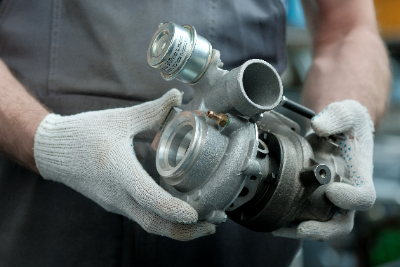All Categories
History

This section provides an overview for turbos as well as their applications and principles. Also, please take a look at the list of 1 turbo manufacturers and their company rankings.
Table of Contents

A turbo, short for turbocharger, is a type of supercharger that utilizes the force of exhaust gases to supply air to the engine.
The turbine is rotated by the force of exhaust gases, and this rotation is used to drive the compressor. The compressor is attached to the intake manifold, compressing air and supplying it to the engine. This mechanism increases the amount of air delivered to the engine, enhancing engine output.
Unlike non-turbocharged engines, turbocharged engines are often referred to as turbo engines. Vehicles equipped with turbochargers offer a significant advantage in producing higher power compared to naturally aspirated (NA) engine vehicles of the same displacement.
Turbochargers find widespread use in high-performance vehicles such as race cars, as well as in large vehicles like trucks and buses. These vehicles require powerful engines, and the use of a turbocharger enhances engine output, improving acceleration performance, especially on highways.
Furthermore, turbochargers are employed in smaller-displacement engines to achieve output comparable to larger-displacement engines, contributing to fuel-efficient and low-emission vehicles. However, a drawback is the increased number of components associated with turbocharging, leading to higher vehicle prices and an increased risk of malfunctions. Additionally, the use of a turbocharger can impact fuel efficiency negatively.
The principle of a turbochargers involves compressing intake air by the rotation of the turbine, thereby increasing the amount of air (oxygen) sent to the engine, resulting in elevated engine output. In a basic engine, a mixture of air and fuel is ignited after vaporization, and the energy produced by the explosion and expansion of the mixture within the cylinder generates driving force.
Importantly, the more air taken in, the higher the number of oxygen molecules available for combustion, leading to a greater explosion and expansion energy. Turbocharged engines can increase the weight of air introduced into the cylinder through forced induction by the turbo, achieving greater energy than naturally aspirated engines.
However, in the low RPM range of the engine, where exhaust gas is minimal, the desired supercharging effect may not occur, resulting in lower-than-expected engine output. To achieve the supercharging effect, it is necessary to increase the turbine rotation speed by increasing exhaust gas, but the rotation speed does not rise immediately when the accelerator is pressed. The delay until the supercharging effect occurs is known as turbo lag, and various innovations are implemented by manufacturers to reduce this lag.
A turbocharger has a structure with two interconnected turbine wheels resembling windmills. When the turbine on the exhaust side (turbine wheel) rotates, it drives the turbine on the intake side (compressor wheel), compressing the intake air. The compressed air is then sent into the engine. Turbochargers achieve forced induction by utilizing the pressure of exhaust gases to compress air.
Air compressed by the turbo increases in temperature, causing a decrease in air density. Reduced air density means a decrease in oxygen concentration. To address this, an intercooler, a component similar in structure to a radiator, is installed between the turbine and the engine. The intercooler cools the compressed air using ambient air or cooling water, increasing air density and minimizing the reduction in engine output.
Turbochargers are classified into several types based on the number of turbines. Most turbocharged engine vehicles are equipped with either a single turbocharger (single-turbo) or two turbochargers (twin-turbo). However, in high-end vehicles, there are models equipped with three turbos (triple-turbo) or four turbos (quad-turbo).
This type involves fitting one turbocharger to the engine, characterized by its cost-effectiveness. It is commonly used in smaller vehicles, providing enhanced output across a wide range of engine speeds, from low to high RPM.
However, the output improvement in the low RPM range tends to be lower compared to the high RPM range, as a single turbocharger must cover a broad range of engine speeds.
This type features two turbochargers attached to the engine, offering a smaller turbo lag and balancing high output with responsiveness. Depending on the engine speed, it can switch between using only one turbo or both turbos simultaneously.
Twin-turbo setups often involve smaller turbines than those in single-turbo configurations. This allows for the rotation of the turbo, even with a smaller displacement, enabling the driving of the compressor.
*Including some distributors, etc.
Sort by Features

Cummins Inc., an American company founded in 1919 and based in Columbus, Indiana, is a manufacturer and supplier of engines, generators, and power systems. The company's product portfolio includes the Cummins X15 engine, natural gas generator sets, and system-level controls and switchgears. These products are used in various industries, including mining, power generation, and the oil and gas industry. The company offers services including technical support, provides a parts catalog, and offers repair services. It has locations in various countries including the United Kingdom, China, and Australia.
Number of Employees
Newly Established Company
Company with a History
1 products found
1 products
Ernest Co., Ltd.
600+ people viewing
Last viewed: 1 day ago
A turbocharger is a component in which the turbine and compressor are fixed to both ends of a single shaft, and the balance between them rotating a...